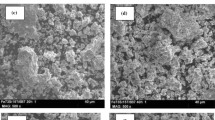Abstract
We report on the synthesis of Bi0.4Sr0.6FeO3 powder with cubic structure by solid state reaction (mechanical milling and calcination) from Bi2O3, SrCO3 and Fe2O3 stoichiometric ratios. Milled powder mixtures were heat treated between 775∘C and 825∘C for 30 and 60 min in oxygen atmosphere and characterized by X-ray diffraction (XRD), impedance as well as Mössbauer spectroscopy. The cubic phase of Bi0.4Sr0.6FeO3 was successfully obtained in samples milled for only 2 h and a subsequent calcination at 800∘C. Irrespective of milling time, heat treatments at lower temperatures (775∘C) still show spurious phases such as Sr0.23Bi0.76O1.1 (30 min) and Sr0.53Bi1.72O3 (60 min). Impedance spectroscopy show high values (105–109) Ω indicating strong structural bond between the atoms of the system and activation energies for the strontium ion around 04 eV. These results show a single dynamic behavior in a range from 1 to 2*105 Hz enabling data adjustment and analysis to a RC circuit. Conductivity results normally show a behavior that obeys the universal law of Jonscher’s relaxation (σ = σ Dc + α ω n) with values for the exponent n (0.8 < n < 1) typical in these structures. Mössbauer spectrometry measurements reveal that the hyperfine magnetic field of the precursors and milled powders corresponds to hematite 512 T. After the thermal treatment of the samples, the mean hyperfine field decreases to 489 ± 0.5 T showing the Bi and Sr atoms diffusion, (non- magnetic) in Fe2O3. While the result of isomer shift corresponds to a Fe+3 oxidation state irrespective of the heat treatment.
Similar content being viewed by others
References
Singhal, S.C., Kenda, K.: High-temperature Solid Oxide Fuel Cells: Fundamentals, Design and Applications, Amsterdam (2003)
Cortes-Escobedo, C.A., Munoz-Saldana, J., Bolarin-Miro, A.M., Sanchez de Jesus, F.: Determination of strontium and lanthanum zirconates in YPSZ—LSM mixtures for SOFC. J. Power Sources 180, 209–214 (2008). doi:10.1016/j.jpowsour.2008.01.067
Brinkman, K., Iijima, T., Takamura, H.: The oxygen permeation characteristics of Bi1-xSrxFeO3 mixed ionic and electronic conducting ceramics. Solid State Ionics 181, 5–58 (2010). doi:doi:10.1016/j.ssi.2009.11.016
Teraoka, Y., Zhang, H.M., Furukawa, S., Yamazoe, N.: Oxygen permeation through perovskite-type oxides. Chem. Lett. 174–1746 (1985). doi:10.1246/cl.1985.174
Jiang, Q., Faraji, S., Slade, D.A., Stagg-Williams, S.M.: A Review of Mixed Ionic and Electronic Conducting Ceramic Membranes as Oxygen Sources for High-Temperature Reactors, pp 235–273. Elsevier BV, Amsterdam (2011)
Niu, Y., Sunarso, J., Zhou, W., Liang, F., Ge, L., Zhu, Z.: Evaluation and optimization of Bi1-xSrxFeO3-d perovskites as cathodes of solid oxide fuel cells. Int. J. Hydrogen Energy 36, 3179–3186 (2011). doi:10.1016/j.ijhydene.2010.11.10
Baek, D., Kamegawa, A., Takamura, H.: Preparation and electrode properties of composite cathodes based on Bi 1 − x Sr x FeO 3 −δ with Perovskite-type structure. Solid State Ionics 262, 691–695 (2014). doi:10.1016/j.ssi.2014.01.00
Folcke, E., Breton, J.M., Le Bréard, Y., Maignan, A.: Mössbauer spectroscopic analysis of Bi1-xSrxFeO3-d perovskites. Solid State Sci. 12, 138–1392 (2010). doi:doi:10.1016/j.solidstatesciences.2010.05.01
Li, J., Duan, Y., He, H., Song, D.: Crystal structure, electronic structure, and magnetic properties of bismuth-strontium ferrites. J. Alloys Compd. 315, 25–264 (2001). doi:10.1016/S0925-8388(00)01313-X
Moure, C., Peña, O.: Recent advances in perovskites: processing and properties. Prog. Solid State Chem. 43, 12–148 (2015). doi:10.1016/j.progsolidstchem.2015.09.00
Larson, A.C., Dreele, R.B., Von Alamos, L.: GSAS (2000)
Telliet, J., Varret, F.: MOSFIT (1976)
Lemine, O.M., Sajieddine, M., Bououdina, M., Msalam, R., Mufti, S., Alyamani, A.: Rietveld analysis and Mössbauer spectroscopy studies of nanocrystalline. J. Alloys Compd. 502, 279–282 (2010). doi:10.1016/j.jallcom.2010.04.17
Jonscher, A.K.: Dielectric relaxation in solids. J. Phys. D. Appl. Phys. 32, R57–R70 (1999). doi:doi:10.1088/0022-3727/32/14/20
Acknowledgments
This project has been carried out partially at CENAPROT and LIDTRA national laboratories.
Author information
Authors and Affiliations
Corresponding author
Additional information
This article is part of the Topical Collection on Proceedings of the 15th Latin American Conference on the Applications of the Mössbauer Effect (LACAME 2016), 13–18 November 2016, Panama City, Panama Edited by Juan A. Jaén
Rights and permissions
About this article
Cite this article
Rico, M., Rodriguez, R., Zapata, V.H. et al. Solid state synthesis of Bi 0 . 4 Sr 0 . 6 FeO 3 − δ powder for SOFC applications. Hyperfine Interact 238, 57 (2017). https://doi.org/10.1007/s10751-017-1427-5
Published:
DOI: https://doi.org/10.1007/s10751-017-1427-5




